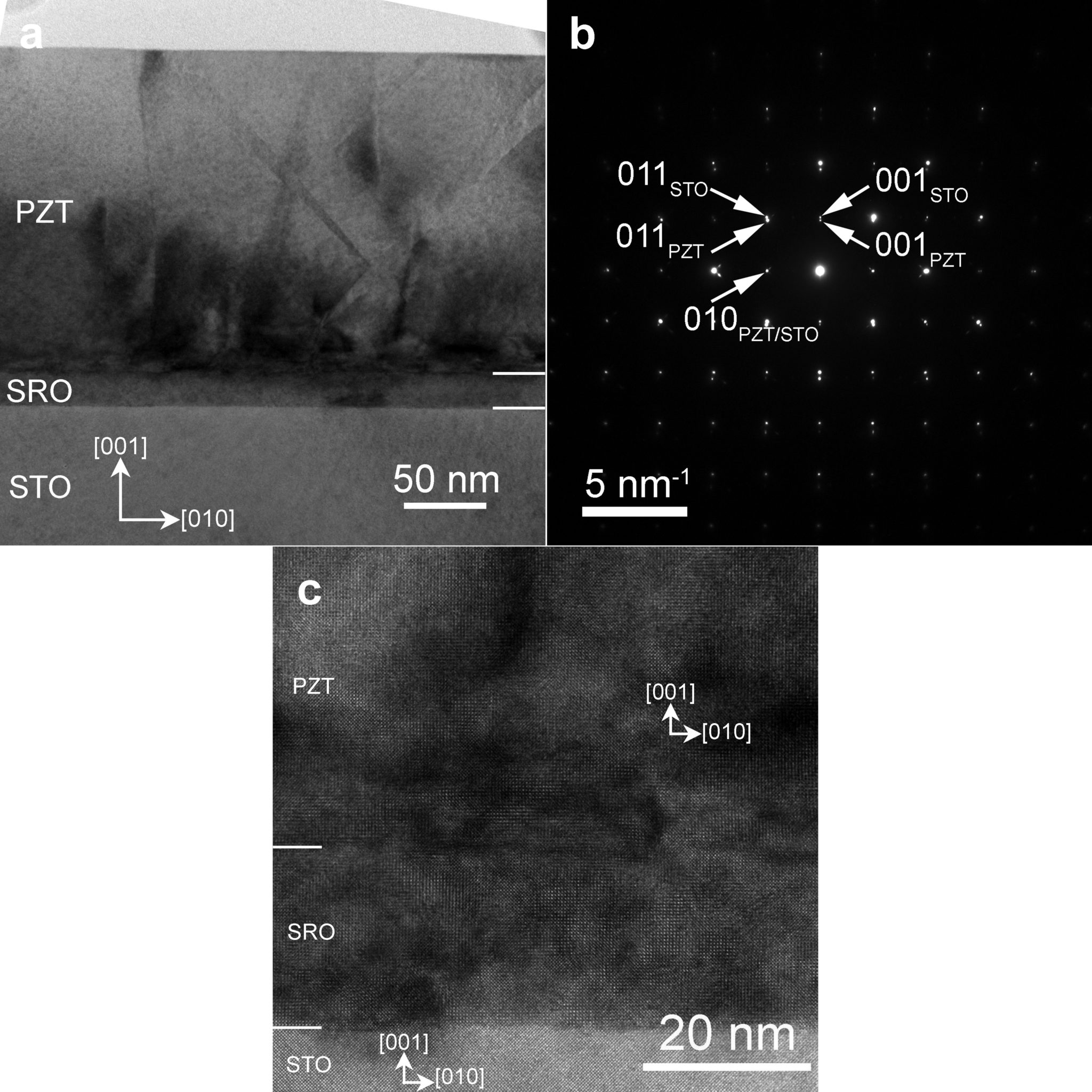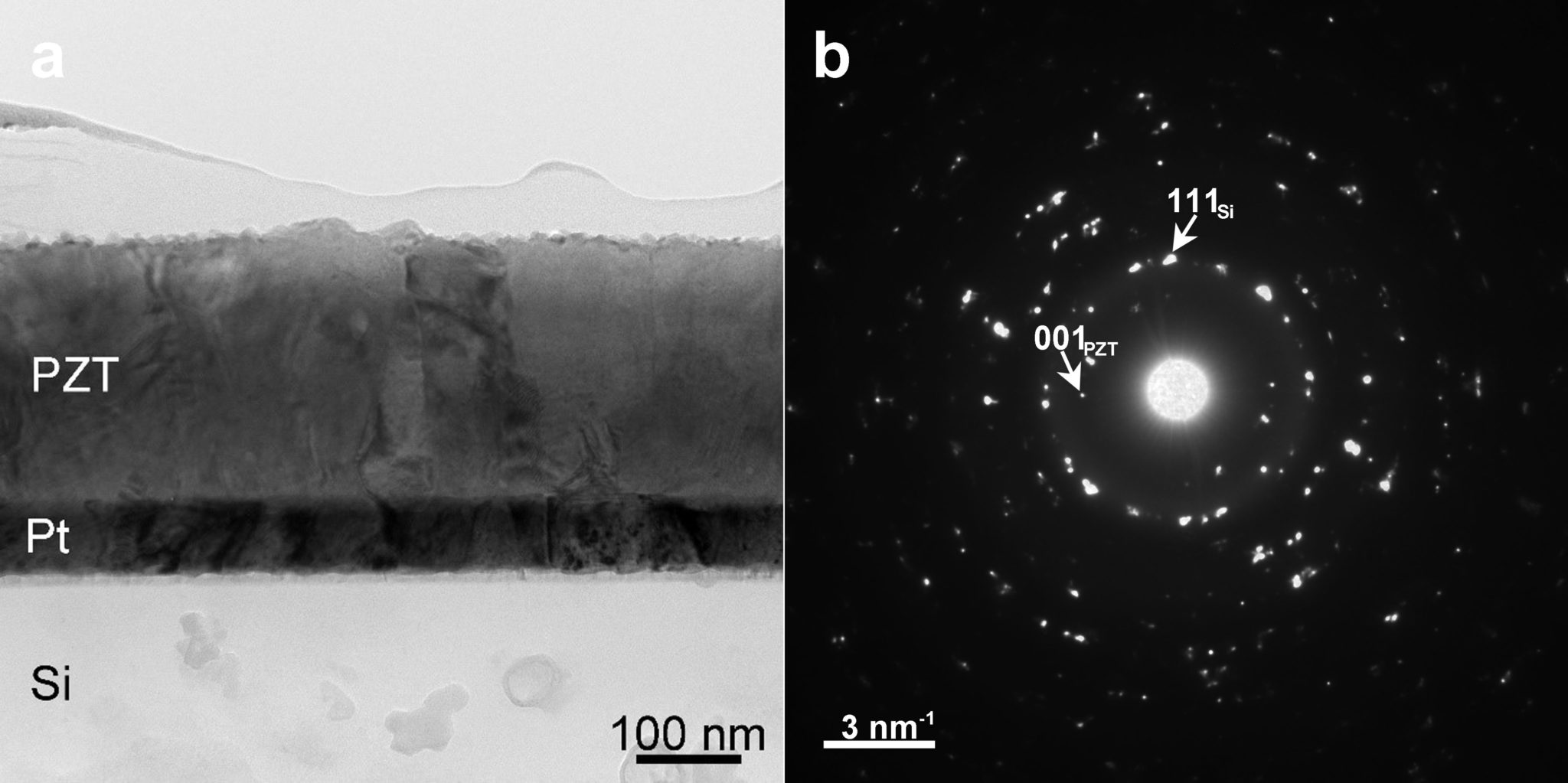CONTROL OF ELECTRONIC PROPERTIES IN FERROELECTRIC PEROVSKITE HETEROSTRUCTURES: FROM THEORY TO APPLICATIONS
Project Director: Dr. Lucian Pintilie
Project ID: PN-III-P4-ID-PCCF-2016-0047 (contract PCCF no. 16 from 2018)
Project Director: Dr. Lucian Pintilie
Project Type: National
Program: Program 4 – Basic and Frontier Research: Complex Projects of Frontier Research
Fundin Agency: Unitatea Executiva pentru Finantarea Invatamantului Superior, a Cercetarii, Dezvoltarii si Inovarii - UEFISCDI
Contractor: NATIONAL INSTITUTE OF MATERIALS PHYSICS (INSTITUTUL NATIONAL DE CERCETARE - DEZVOLTARE PENTRU FIZICA MATERIALELOR)
Status: In progress
Starting Date: 10 Octombrie 2018
Endin Date: 3 November 2022
Summary:
The main objective of the project is to obtain ferroelectric materials with controlled electronic properties at the same level as these properties are controlled in Si. This will be realized by hetero-valent doping, correlated with stress engineering and band gap engineering without affecting, as much as possible, the ferroelectric properties. The main objective is complex and ambitious because, up to date, there was no experimental demonstration that it possible to obtain n or/and p type conduction in epitaxial ferroelectrics. The successful achievement of this objective will open a new domain, that of ferroelectric electronics or ferrotronics, by producing electronic devices of p-n homo-junction type or junction transistors with ferroelectric materials. Two types of materials are envisaged, namely lead titanate-zirconate (PZT with tetragonal structure and a mixed bismuth ferrite (BFO) with bismuth chromit (BCO). In the first case the heterovalent doping will be studied on Pb or Zr/Ti sites with the aim to obtain n and p type conduction. The final goal is to produce a p-n homo-junction based on epitaxial PZT films. In the second case band gap engineering will be tested by varying the Fe/Cr content, and the dominant conduction mechanism will be identified, the goal being to use the material in photovoltaic applications. The activities will contain: theoretical studies regarding the relation between dopants, electronic properties and the ferroelectricity, including self-doping effects or electrostatic doping; target preparation for deposition of thin films; epitaxial growth of the film; characterization activities of the structure and physical properties. Not only classic doping in the target is envisaged but also doping during the epitaxial growth. The consortium is composed of 4 teams from three different institutions, including a number of 14 young researchers full time equivalent.
Specific objectives:
O1. Accurate control of doping of ferroelectric thin films. In a first stage pure ferroelectric PZT films will be grown, from a pure target manufactured in the frame of the project. In a second stage, doped ferroelectric films will be obtained, from targets with controlled doping. The goal is to obtain p-n ferroelectric homo-junction.
O2. Design and fabrication of FeRAM memory cells with non-destructive readout. Capacitive, conductive and pyroelectric readout will be tested.
O3. Design and fabrication of multi-bit FeRAM memory devices. One can try to obtain structures with multiple polarization states.
O4. Develop new architectures for the next generation photovoltaic solar cells. One can try to obtain ferroelectric thin films with photovoltaic properties, as well as integration of ferroelectrics in perovskite solar cells.
The project will be implemented by a consortium composed of: coordinator (CO-INCDFM, thin film deposition, electrical measurements, device characterization), partner 1 (P1-INCDFM, structural and chemical analysis using TEM and XPS), partner 2 (P2-INCDTIM, theory), partner 3 (P3-UPB, realization of ceramic targets).
Activities are groupd in 6 workpackages (WP):
WP1. Theory and simulations. CO and P2 will collaborate for theoretical modelling of dopants in ferroelectrics.
WP2. Target preparation. CO and P3 will collaborate to realize the undoped and doped targets.
WP3. Growth of the epitaxial ferroelectric films. CO will grow the epitaxial ferroelectric layers by PLD.
WP4. Structural and chemical characterization of the epitaxial films. CO and P1 will collaborate for structural and chemical characterization using XRD, TEM, XPS techniques.
WP5. Electrical characterization of the epitaxial films and ferrotronic devices. CO will investigate the physical properties of epitaxial layers by complex electrical measurements and will characterize the ferrotronic devices for memory and photovoltaic applications.
WP6. Management, dissemination and patenting. Reporting, publishing and patenting activities.
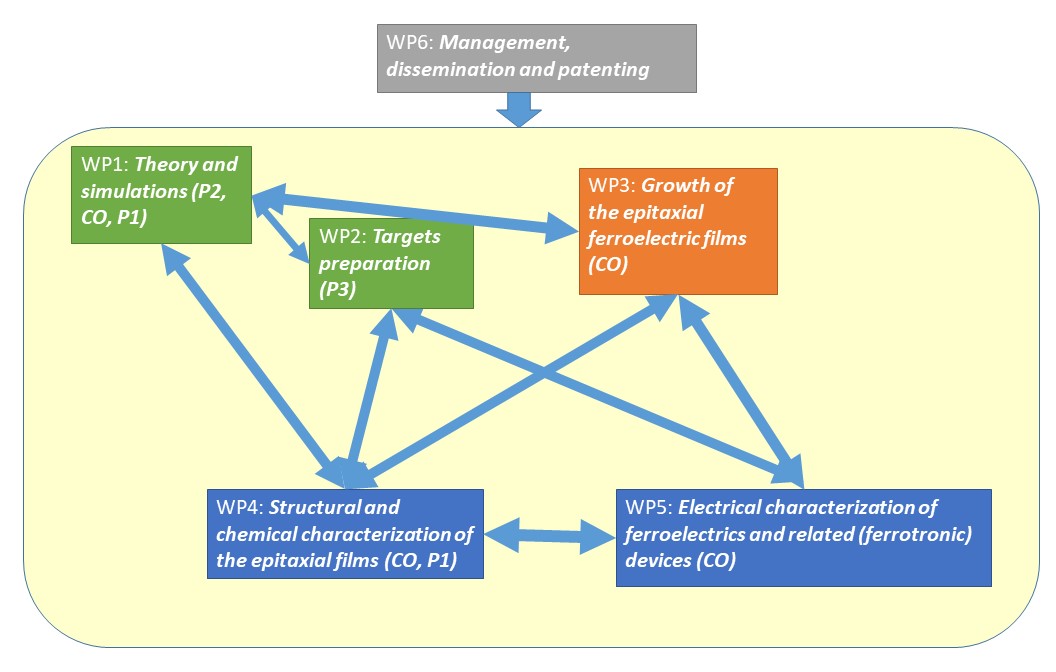
Relation between WPs.
| Nr. Crt. | Institution | Name and link to brainmap | Scientific rank in Romanian research hierarchy | Role in the project |
| 1 | INCDFM-CO | Lucian Pintilie https://www.brainmap.ro/lucian-pintilie | Scientific Researcher rank I | Project Director |
| 2 | INCDFM-P1 | Teodorescu Cristian-Mihail https://www.brainmap.ro/cristian-mihail-teodorescu | Scientific Researcher rank I | Responsible P1 |
| 3 | INCDTIM-P2 | Liviu Zarbo https://www.brainmap.ro/liviu-zarbo | Scientific Researcher rank I | Responsible P2 |
| 4 | UPB-P3 | Adelina Carmen Ianculescu https://www.brainmap.ro/adelina-carmen-ianculescu | University Professor | Responsible P3 |
| 5 | INCDFM-CO | Cristina Chirila https://www.brainmap.ro/cristina-chirila | Scientific Researcher rank III | Post Doc |
| 6 | INCDFM-CO | Boni Andra Georgia https://www.brainmap.ro/andra-georgia-boni | Scientific Researcher rank III | Post Doc |
| 7 | INCDFM-CO | Luminita Hrib https://www.brainmap.ro/luminita-mirela-hrib | Scientific Researcher rank III | Post Doc |
| 8 | INCDFM-CO | Roxana Radu https://www.brainmap.ro/roxana-radu | Scientific Researcher rank III | Post Doc |
| 9 | INCDFM-CO | Ioana Pintilie https://www.brainmap.ro/ioana-pintilie | Scientific Researcher rank I | Experienced Researcher |
| 10 | INCDFM-CO | Iuliana Pasuk https://www.brainmap.ro/iuliana-pasuk | Scientific Researcher rank III | Experienced Researcher |
| 11 | INCDFM-CO | Lucian Trupina https://www.brainmap.ro/lucian-trupina | Scientific Researcher rank III | Experienced Researcher |
| 12 | INCDFM-CO | Viorica Stancu https://www.brainmap.ro/viorica-stancu | Scientific Researcher rank III | Experienced Researcher |
| 13 | INCDFM-CO | Andrei Tomulescu https://www.brainmap.ro/andrei-gabriel-tomulescu | Assistant Researcher | PhD student |
| 14 | INCDFM-CO | Cristina Besleaga https://www.brainmap.ro/cristina-besleaga-stan | Scientific Researcher rank III | Post Doc |
| 15 | INCDFM-CO | Galca Catalin Aurelian https://www.brainmap.ro/aurelian-catalin-galca | Scientific Researcher rank I | Experienced Researcher |
| 16 | INCDFM-CO | George Stan https://www.brainmap.ro/george-stan | Scientific Researcher rank I | Experienced Researcher |
| 17 | INCDFM-CO | Liliana Balescu https://www.brainmap.ro/liliana-marinela-balescu | Scientific Researcher | Post Doc |
| 18 | INCDFM-CO | Rusu Dorin https://www.brainmap.ro/dorin-rusu | Master student | Master student |
| 19 | INCDFM-CO | Daniela Dogaru https://www.brainmap.ro/daniela-maria-dogaru | Master student | Master student |
| 20 | INCDFM-P1 | Nicoleta Georgiana Apostol https://www.brainmap.ro/nicoleta-georgiana-apostol | Scientific Researcher rank II | Experienced Researcher |
| 21 | INCDFM-P1 | Tanase Liviu https://www.brainmap.ro/liviu-cristian-tanase | Scientific Researcher | Post Doc |
| 22 | INCDFM-P1 | Ioana Cristina Bucur https://www.brainmap.ro/ioana-cristina-bucur | Assistant Researcher | PhD student |
| 23 | INCDFM-CO | Neculai Plugaru https://www.brainmap.ro/neculai-plugaru | Scientific Researcher rank I | Experienced Researcher |
| 24 | INCDFM-CO | Lucian Dragos Filip https://www.brainmap.ro/lucian-dragos-filip | Scientific Researcher rank II | Experienced Researcher |
| 25 | INCDFM-P1 | Bocirnea Amelia-Elena https://www.brainmap.ro/amelia-bocirnea | Assistant Researcher | PhD student |
| 26 | INCDFM-P1 | Corneliu Ghica https://www.brainmap.ro/corneliu-ghica | Scientific Researcher rank I | Experienced Researcher |
| 27 | INCDFM-P1 | Raluca Negrea https://www.brainmap.ro/raluca-florentina-negrea | Scientific Researcher | Post Doc |
| 28 | INCDFM-P1 | Andrei Cristian Kuncser https://www.brainmap.ro/andrei-kuncser | Scientific Researcher | Post Doc |
| 29 | INCDTIM-P2 | Sorina Garabagiu https://www.brainmap.ro/sorina-garabagiu | Scientific Researcher rank II | Post Doc |
| 30 | UPB-P3 | Daniela Cristina Berger https://www.brainmap.ro/daniela-cristina-berger | University Professor | Experienced Researcher |
| 31 | UPB-P3 | Melinescu Alina https://www.brainmap.ro/alina-melinescu | Associate Professor | Experienced Researcher |
| 32 | UPB-P3 | Mihai Eftimie https://www.brainmap.ro/mihai-eftimie | Lector | Experienced Researcher |
| 33 | UPB-P3 | Vasile Bogdan https://www.brainmap.ro/bogdan-stefan-vasile | Scientific Researcher rank III | Experienced Researcher |
| 34 | UPB-P3 | Surdu Adrian Vasile https://www.brainmap.ro/vasile-adrian-surdu | PhD student | PhD student |
| 35 | INCDFM-P1 | Daniela Ghica https://www.brainmap.ro/daniela-ghica | Scientific Researcher rank II | Experienced Researcher |
| 36 | INCDFM-P1 | Mariana Stefan https://www.brainmap.ro/mariana-stefan | Scientific Researcher rank II | Experienced Researcher |
| 37 | INCDFM-P1 | Stavarache Ionel https://www.brainmap.ro/ionel-stavarache | Scientific Researcher rank II | Experienced Researcher |
| 38 | INCDFM-P1 | Ana Maria Lapadatu https://www.brainmap.ro/ana-maria-lepadatu | Scientific Researcher rank III | Post Doc |
| 39 | INCDFM-CO | Teddy Tite https://www.brainmap.ro/teddy-tite | Scientific Researcher rank III | Experienced Researcher |
| 40 | INCDFM-P1 | Marius-Adrian Husanu https://www.brainmap.ro/marius-adrian-husanu | Scientific Researcher rank II | Experienced Researcher |
| 41 | INCDFM-P1 | Elena Laura Abramiuc https://www.brainmap.ro/laura-abramiuc | Scientific Researcher | Post Doc |
| 42 | INCDFM-P1 | Marian Cosmin Istrate https://www.brainmap.ro/marian-cosmin-istrate | Assistant Researcher | PhD student |
| 43 | INCDFM-P1 | Adela Nicolaev https://www.brainmap.ro/adela-nicolaev | Scientific Researcher rank III | Post Doc |
| 44 | INCDFM-CO | Roxana Elena Patru https://www.brainmap.ro/roxana-elena-patru | Scientific Researcher | Post Doc |
| 45 | INCDFM-P1 | Adrian - Constantin Pena https://www.brainmap.ro/adrian-constantin-pena | PhD student | PhD student |
| 46 | INCDTIM-P2 | Cristian Morari https://www.brainmap.ro/ioan-cristian-morari | Scientific Researcher rank I | Experienced Researcher |
| 47 | INCDTIM-P2 | Calin Gabriel Floare https://www.brainmap.ro/calin-gabriel-floare | Scientific Researcher rank III | Post Doc |
| 48 | UPB-P3 | Roxana Doina Trusca https://www.brainmap.ro/roxana-doina-trusca | PhD student | PhD student |
| 49 | UPB-P3 | Catalina Stanciu https://www.brainmap.ro/catalina-stanciu | Scientific Researcher | Post Doc |
| 50 | INCDFM-P1 | Cristian Radu https://www.brainmap.ro/cristian-radu | PhD student | PhD student |
| 51 | UPB-P3 | Nicoara Adrian https://www.brainmap.ro/adrian-ionut-nicoara | PhD student | PhD student |
| 52 | INCDTIM-P2 | Larisa Milena Timbolmas https://www.brainmap.ro/larisa-milena-timbolmas | PhD student | PhD student |
| 53 | INCDFM-CO | Mihaela Botea https://www.brainmap.ro/mihaela-botea | Scientific Researcher rank III | Post Doc |
| 54 | INCDFM-CO | Sarah Derbali https://www.brainmap.ro/sarah-derbali | Assistant Researcher | PhD student |
During the project implementation interesting results were obtained regarding the presence of negative capacitance effect in ferroelectric capacitors of PZT type. This effect can help to reduce the power consumption in field effect transistors, including for non-volatile memories. The topic is intensively studied, with publications in prestigious journals, such as Nature. The Project Director is co-author to the article published in Nature 565, 464 (2019).s41586-018-0854-z
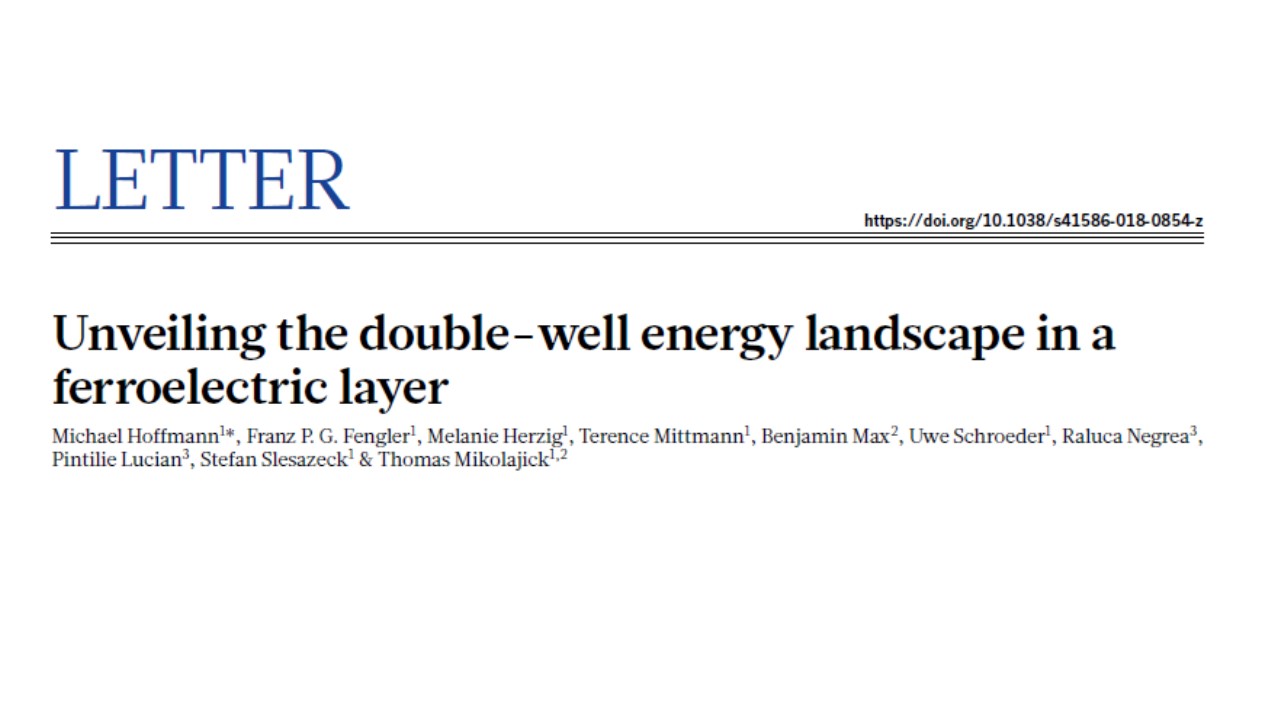
Considering the importance of the subject, research was initiated to investigate the presence of the negative capacitance effect in the samples grown in the frame of the project. The obtained results were published in Physical Review Applied.
The Project Director was the main organizer of the 6th edition of the International Workshop of Materials Physics (IWMP). Below are the first announcement and the program of IMP.
First Announcement
14-16 of September 2021
The National Institute of Materials Physics (NIMP) announces the organization of the 6th edition of the International Workshop of Materials Physics (IWMP). The topic for 2021 edition is dedicated to ferroelectric and multiferroic materials, with special emphasis on thin films, multilayers, super-lattices and nano-objects. Aspects related to modeling, fabrication, characterization and potential applications will be presented and discussed.
Similar to the first five editions, the 6th edition of IWMP is organized on invitation only. The aim is to attract well known researchers in the field, the final purpose being to establish new collaborations concretized in common publications, projects and exchange of personnel.
Young researchers willing to present their latest results on topics related to the main topic of the workshop are invited to submit a 2 page abstract (A4, Times New Roman 11, single spacing, 2 cm margins, including figures and references) to the organizers (pintilie@infim.ro). The best abstracts will be selected for oral presentations during the workshop.
The workshop will take place at NIMP premises located in Magurele, Romania.
Workshop Program
14 of September
9:00 – 9:10 Opening
9:10-9:50: Liliana Mitoseriu: Scale-dependent properties in BaTiO3 ceramics with structural instability
9:50-10:30: Antonio Casares (on-line): Multi-Modal-Correlative Microscopy (sponsor presentation, Zeiss)
10:30-11:10: Maryline Guilloux-Viry (on-line): Niobates Ferroelectric Thin Films: i/ Growth and Characterization of Perovskite and TTB Phases in the K-Na-Nb-O System; ii/ Potential of Application in High Frequency Miniature Tunable Devices
11:10 – 11:30 coffee break
11:30-12:10: Michael Springborg: Shapes (of) Matter
12:10-12:50: Ibrahim Burc Misirlioglu (on-line): Interface limited stability of ferroelectricity in thin film heterostructures: Electrostatic interactions, elasticity effects and phase coexistence
12:50-13:30: Jorge Iniguez: Optimizing steady-state negative capacitance
13:30 – 14:30 lunch
14:30-15:10: Josep Fontcuberta: Electron transport and plasmonic response of metallic oxides
15:10-15:50: Valerie Demange: Oxide nanosheets as seed layers for epitaxial growth of complex oxides
15:50-16:30: Brian Rodriguez: AFM tip-induced strain effects in BiFeO3 films: from structural phase changes to polarization switching and nanofabrication
16:30 – 16:45 coffee break
16:45-17:25: Marty Gregg (on-line): Conducting Ferroelectric Domain Walls: Fundamentals of Transport and Device Opportunities
17:25-18:05: Alexei Gruverman (on-line): Unconventional Dynamics of Domain Walls in Uniaxial Ferroelectric Lead
Germanate
19:15 dinner
15 of September
9:00-9:40: Marin Alexe: Incommensurate spin crystal phases in ferromagnetic and ferroelectrics
9:40-10:20: Brahim Dkhil: Playing with domains in ferroelectric polymers and hidden states in relaxors for neuromorphic computing
10:20-11:00: Gustau Catalán: Switching dynamics and “giant” electrocooling effect of antiferroelectric PbZrO3.
11:00 – 11:20 coffee break
11:20-12:00: Vincent Garcia: Controlling antiferromagnetic textures in BiFeO3 multiferroic thin films
12:00-12:40: Nathalie Jedrecy (on-line): Electro- and magneto- resistance in perovskite-based multiferroic junctions
12:40-13:20: Pavlo Zubko (on-line): Domains and lattice curvature in ferroelectric superlattices and supercrystals
13:20 – 14:30 lunch
14:30-15:10 Torsten Granzow: Anomalous photovoltaic effect in low-leakage solution-deposited BiFeO3 films: Influence of doping and substrate stress
15:10-15:50: Igor Stolichnov: Switching in HfO2-based ferroelectrics: an insight from nanoscopic analysis
15:50-16:30: Marie-Helen Chambrier: Ferroelectric state in a α-Ln2WO6 polymorphes stabilized in thin film
16:30 – 16:45 coffee break
16:45-17:25: Gregory S. Rohrer (on-line): High Throughput Studies of Metal Oxide Water Splitting Catalysts for the Development of Structure-Property Relations
17:25: 18:05: Eric L. Altman (on-line): Coupling Elastic, Electrostatic and Magnetic Responses in Transition Metal Silicate Monolayers
19:15 dinner
16 of September
9:00-9:40: Nick Barrett: Interface chemistry, oxygen vacancies, charge injection and polarization stability in ferroelectric hafnia-based films for non-volatile memories
9:40-10:20: Uwe Schroeder: Stabilization of the Ferroelectric Phase in Doped Hafnium Oxide Films: Influence of Dopants and Oxygen Vacancies
10:20-11:00: Athanasios Dimoulas (on-line): Scaling of HZO ferroelectric in Ge MFS for low power FTJ
11:00 – 11:20 coffee break
11:20-12:00: Bertrand Vilquin: Nanostructuration effect on the wake-up effect of Hf0.5Zr0.5O2 capacitor
12:00-12:20: Cristian Mihail Teodorescu: Charge accumulation, conduction band filling and ferroicity
12:20-12:40: Georgia Boni: Dynamic dielectric characterization of ferroelectric capacitors- Evidencing negative capacitance
12:40-13:00: Leontin Padurariu: Dynamic Finite Element Method for describing complex dielectric properties in ferroelectric-based composites
13:00-13:20: Marius Husanu: Ferroelectricity and rhombohedral distortion in the electronic band structure of strained PbZrTiO3
13:20 – 14:30 lunch
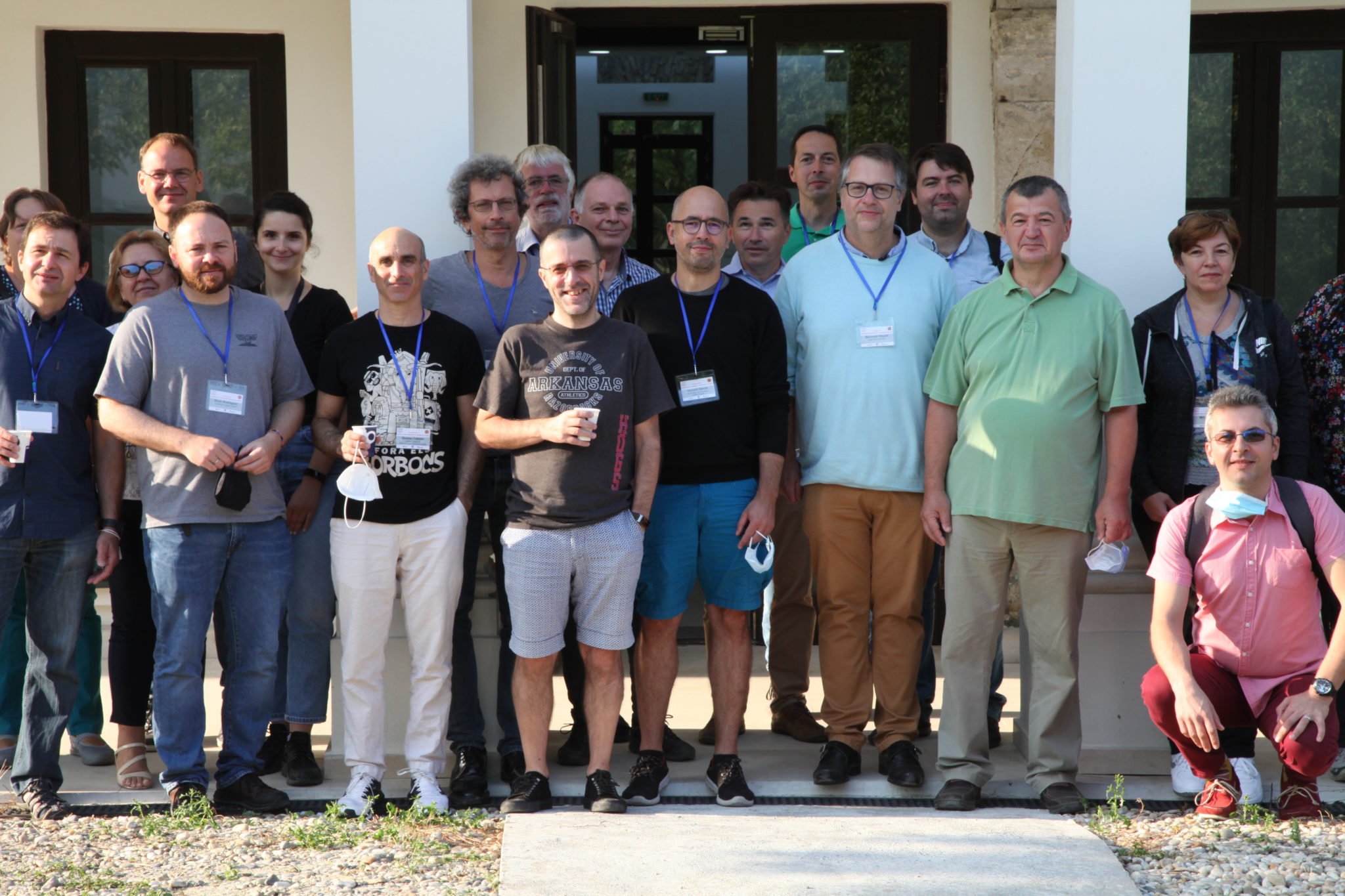
Group photo with the participants to 6th edition of IWMP.
Scientific Report Phase 2, 2019
Important results
Theory and modelling-effect of dopants on PTO energetic structure

Figure 1: Comparison of total DOS between the non doped PTO structure (a) and three cases of unsuccessful p-type dopant: b) Na substitution of Pb atom; c) Pb vacancy and d) Na substitution of Ti atom.

Figure 2: Total DOS comparison between the non doped PTO (top plot) and the spin polarized total DOS for the Fe substitution of Ti atom case (bottom plot). The red and blue lines represent the contribution to the DOS of the Fe atom (spin-up in red and spin-down in blue).
PZT thin films-properties
It was evidenced that the background static dielectric constant in PZT is of low value and depends on the amount of structural defects and on the magnitude of the applied electric field.

Fig. 3a) The thickness dependence of the dielectric constant evaluated from C-V measurements performed at 100 kHz. Evaluation was performed in three cases: at 0V “static”; at 0V “dynamic”; at maximum applied voltage “dynamic”; b) TEM images for 20 nm and 150 nm thick samples (inside each image the notations are a-low magnification image cross-section; b-SAED image; c-low magnification HR-TEM image; d-high magnification HR-TEM image of PZT/SRO interface and SRO/STO interfaces; these images demonstrate the high quality of the epitaxial growth).
Memcapacitance and memcomputing was demonstrated in layered ferroelectric structures

FIG. 4. Logic operation using an F-I -F capacitor. The representation of the polarization states in an F-I -F structure during different stages (initialization and computation) of a logic operation for the OR/NOR case (a) and for the AND/NAND case (b), together with the corresponding simulations of the logic operations obtained by changing the capacitance state (HCS or LCS) of the system using different combinations of pulses. The HCS and LCS states can have 0 or 1 values associated for logic operations and the results are memorized on the computation cell and can be accessed at any time.

FIG. 5. Multiple stable states with continuous capacitive values. (a) A continuous spectrum of capacitance values, with stable intermediate states measured for the STO interlayer case at 1 kHz frequency with 0.5-V ac signal; insets show schematic illustrations of polarization configurations associated with distinct capacitive states. (b) An example of a voltage sequence combining pulses with different amplitudes and polarities used to access different capacitive states. (c) The piezoresponse phase signal obtained using the poling map: the upper PZT layer present totally reverses polarization toward the surface for negative applied bias (bright central rectangular zone) while for positive bias the polarization remains partially reversed, forming with 180◦ domain structure. (d) The piezoresponse phase signal obtained by applying the poling map with a voltage gradient on the totally reversed polarization area from (c): the switching of polarization takes place gradually with increasing the amplitude of voltage; different degrees of partial switching of polarization are obtained in the 8–37 V range.
It was shown, by XPS analysis, that the compensation mechanism changes from intrinsic (with carriers generated in ferroelectric by self-doping) to extrinsic (with carriers from metal electrodes, as the electrode thickness increases.

Variation of the atomic O/Ti ratio indicating the source of oxygen vacancy (a) for the system ferroelectric/metal, with different electrode metals and polarization orientations (b). (c) the charge profile associated to oxygen vacancy density for different thicknesses of the metal layer. (d) the band bending at the interface.
Important results 2020
The effect of negative capacitance (NC) was evidenced in PZT epitaxial capacitors (Phys. Rev. Applied 14, 014080 (2020)). NC occurs during polarization switching, being accompanied by a large increase of the current flowing through the capacitor.
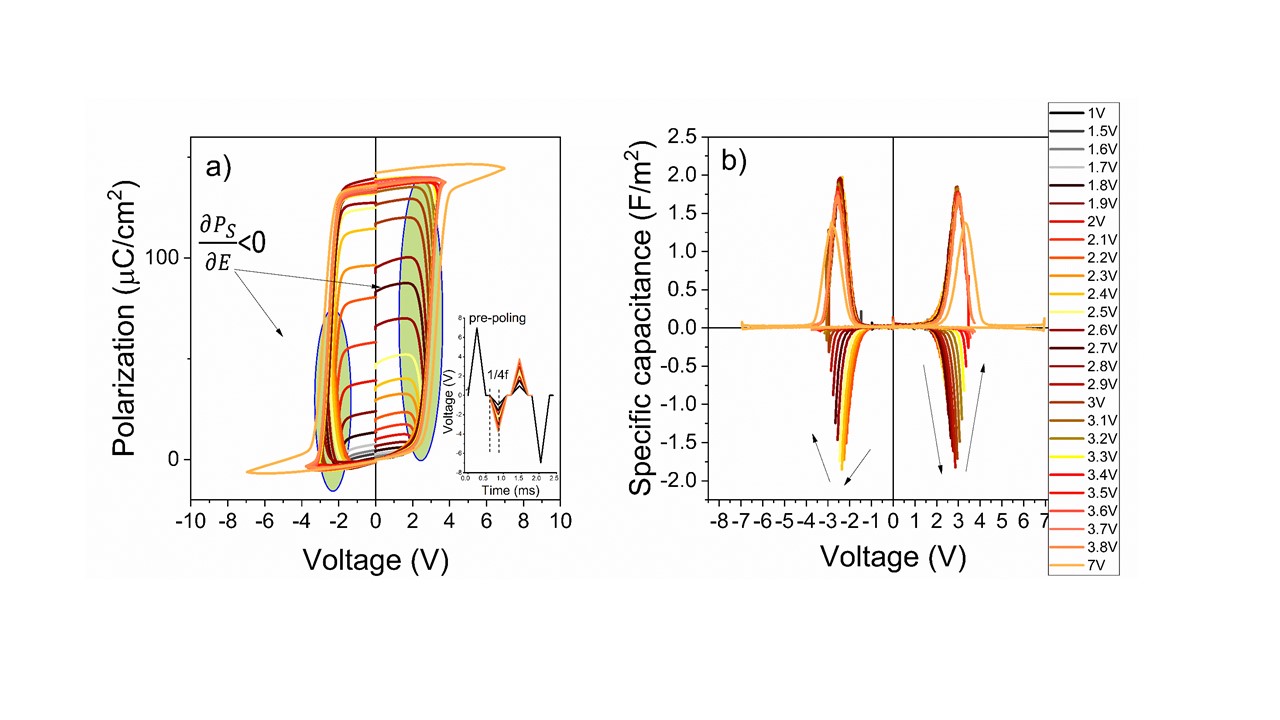
Fig. 2 a) the opening of the polarization hysteresis loop as the amplitude of the triangular voltage pulse is gradually increased (the red arrow mark the increase); b) the C-V characteristics derived from the hysteresis loops presented in fig. 2a. The arrows mark the increase and decrease of negative capacitance observed for voltages corresponding to the domains marked in fig. 2a).
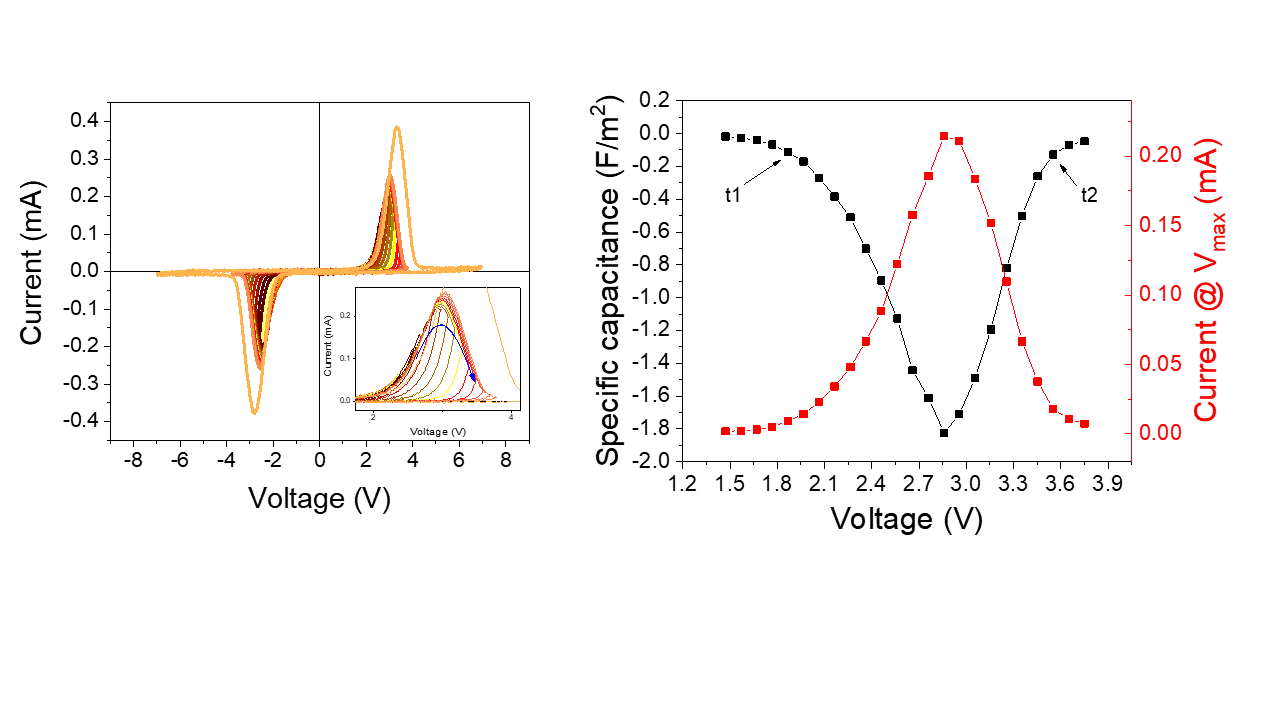
Fig. 3 a) current hysteresis recorded during the hysteresis measurements (associated to hysteresis loops presented in fig. 2a); b) the voltage dependence of the maximum value of negative capacitance in the positive voltage range (see also the arrows in fig. 2a), together with the voltage dependence of the current recorded at maximum applied voltage during the hysteresis measurement.
It was proposed that, in high quality epitaxial PZT films, the polarizations switching may have place without formation of domains with opposite orientation of polarization, as suggested by the Figure below.
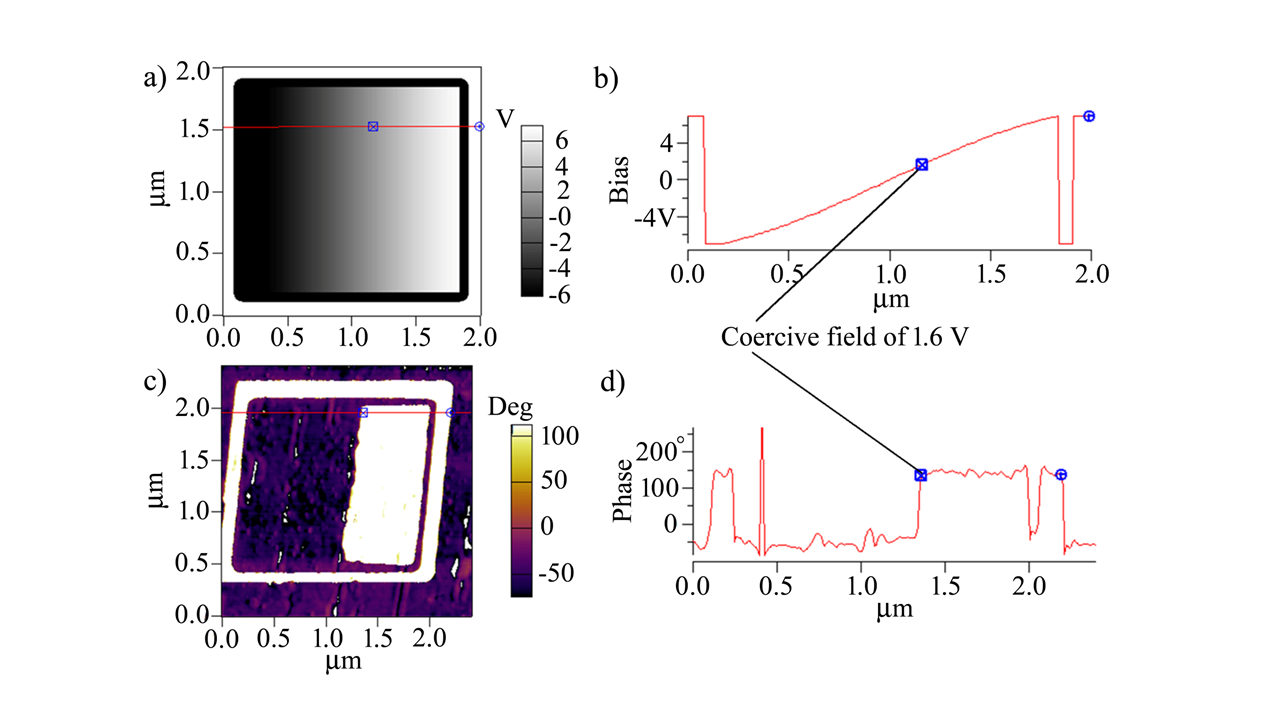
Fig. 4 a) the poling map; b) the voltage variation while the PFM tip scanned the line in Figure 4 a)-it starts with +5.33 V, then after about 0.1 µm drops to -5.33 V and starts to slowly increase to +5.33 V while the tip is moving on the surface of the sample, after which drop again to -5.33 V for about 0.1 µm and suddenly change to +5.33 V for the final 0.1 µm; c) the phase contrast after applying the poling map from Figure 4 a); the phase variation while the tip scans the line in Figure 4 c).
Pure target was prepared (99.99 % purity) and films were deposited both from this target and from a commercial target with 99.9 % purity. The structural and physical characterization revealed important differences: c-lattice constant is slightly larger for the film deposited from commercial target; polarization is slightly lower for the film deposited from pure target; leakage current is lower in the film deposited from pure target and the potential barrier at electrode interfaces are higher. All these differences are attributed to anion impurities that are present in the commercial target and that an affect the electronic properties but also the strain in the lattice.
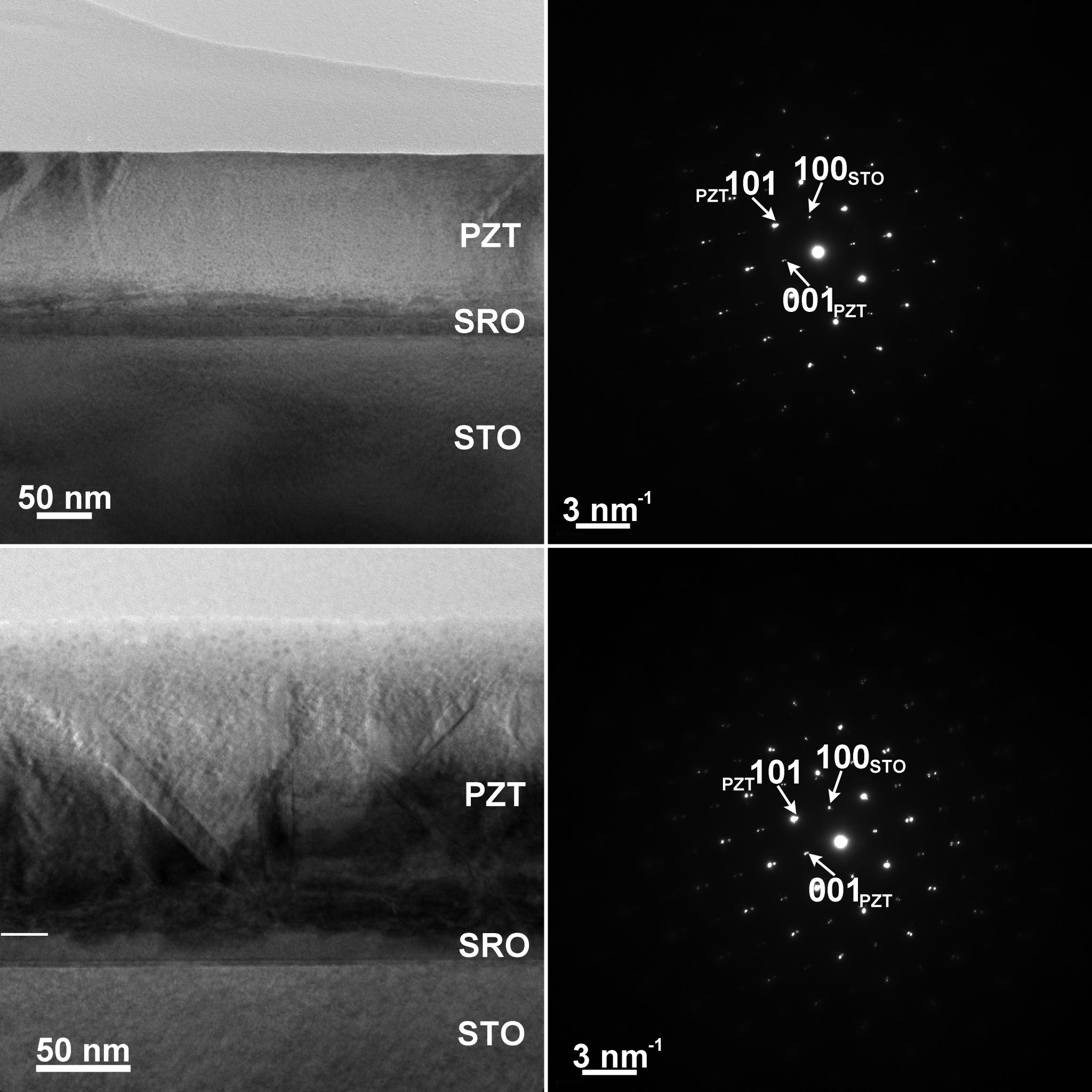
TEM and SAED images of the films deposited from commercial target (upper line) and pure target (lower line)
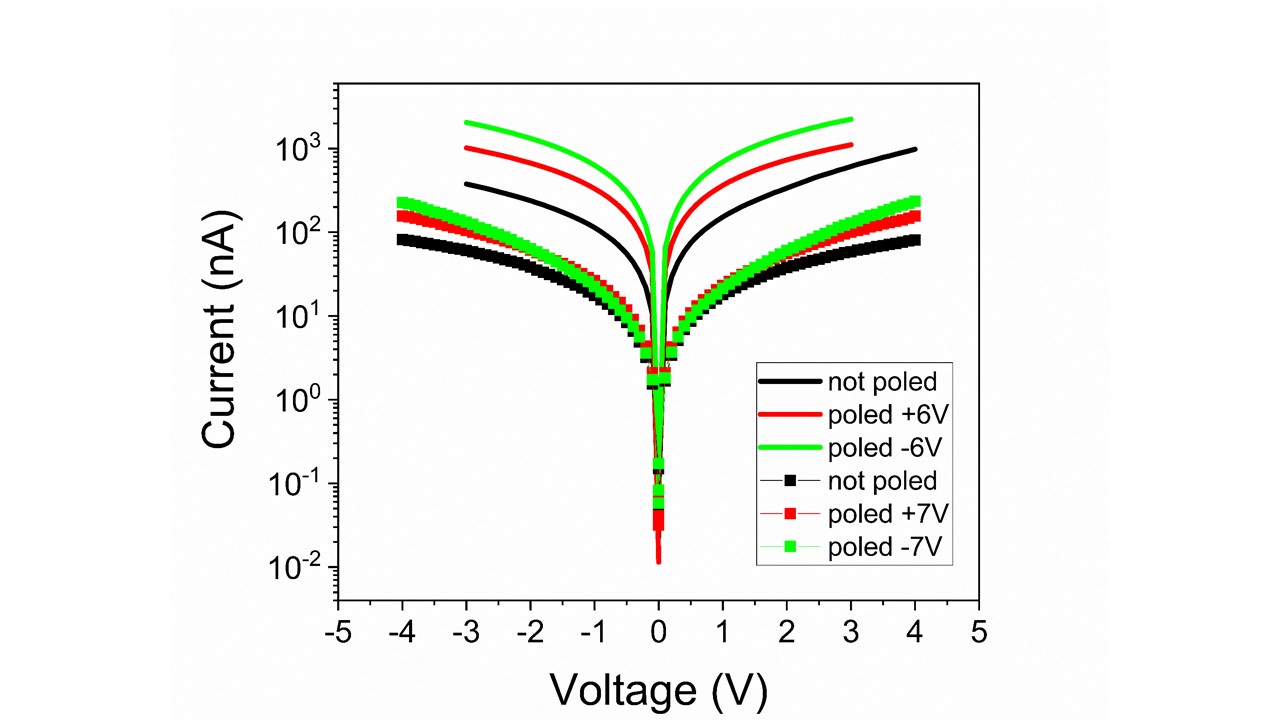
Measured leakage current in films deposited from commercial target (line) and pure target (markers).
First attempts were made to deposit doped films. Co-deposition method was used meaning successive deposition of layers from the pure PZT target and from Nb oxide or Fe oxide targets. TEM studies revealed that co-deposition is perturbing the epitaxial growth. However, significant differences were obtained in the electrical properties.
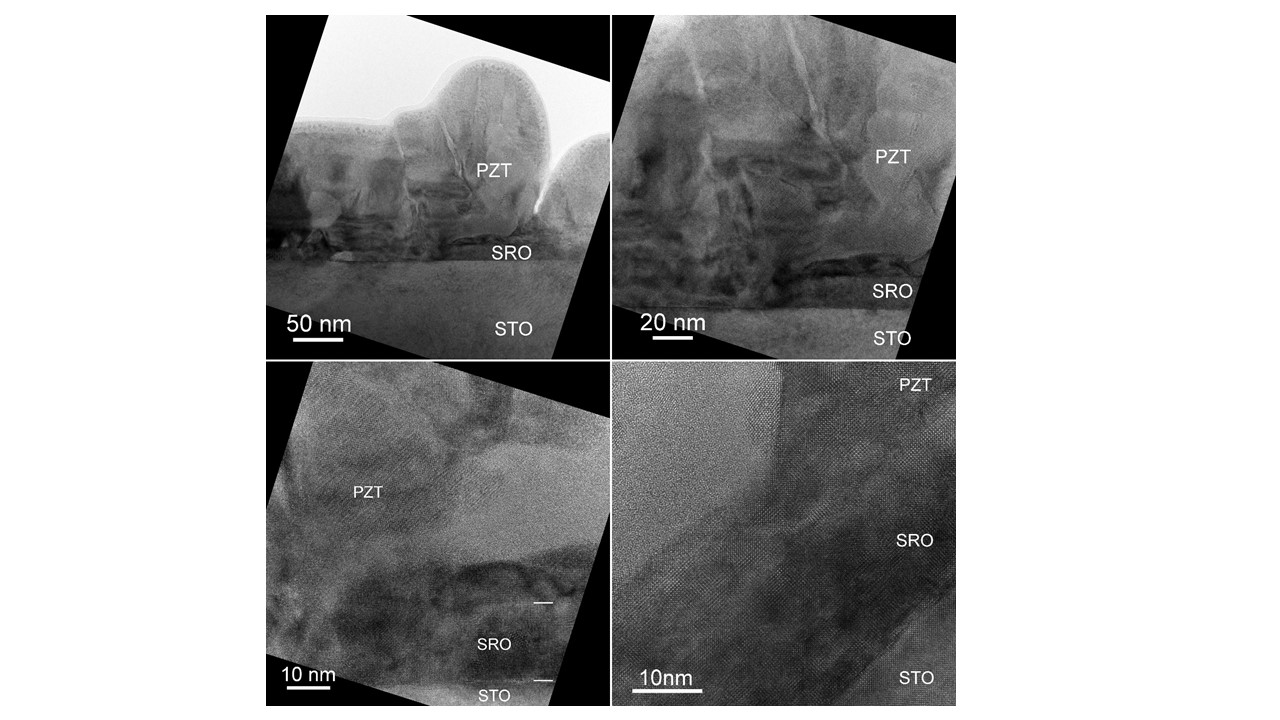
TEM images for the Nb doped PZT by co-deposition.
An interesting results was obtained when graphene was deposited on ferroelectric PZT. The graph below shows the conductance hysteresis in graphene, produced by polarization switching (published in RSC Adv., 2020, 10, 1522).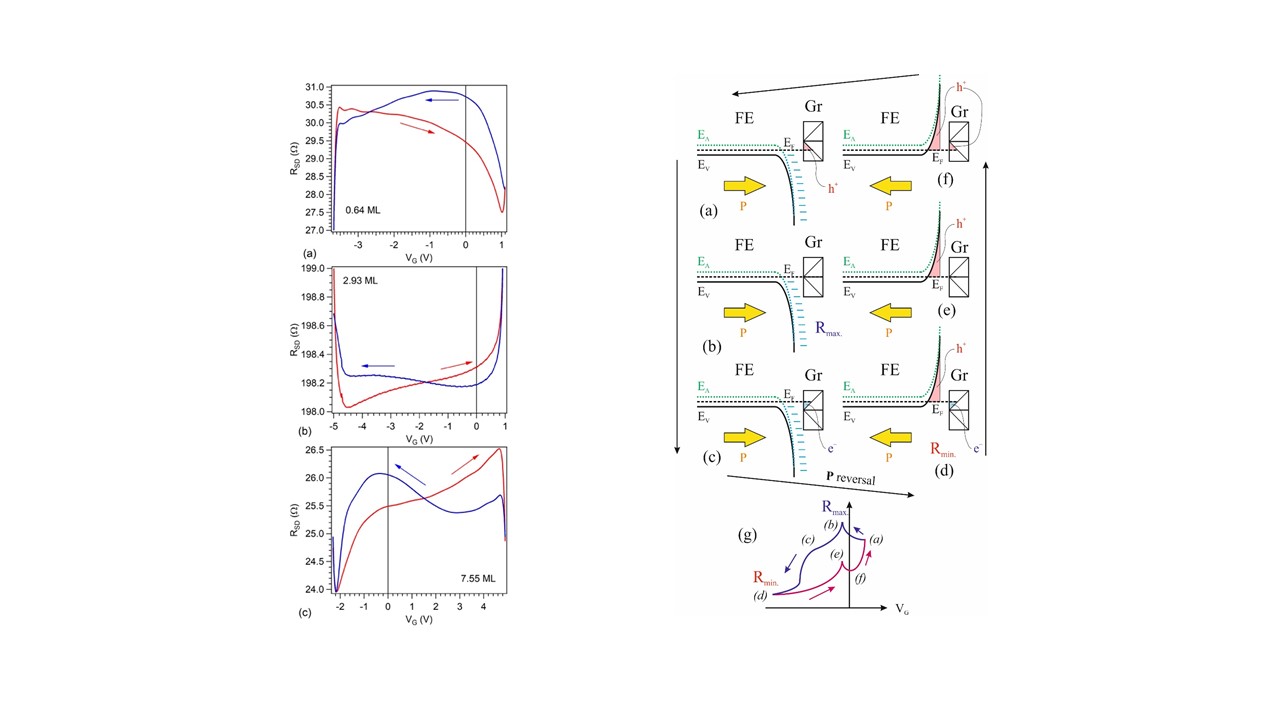
Left-the resistance hysteresis in graphene deposited on PZT; right-schematic showing how polarization switching in PZT can produce the hysteresis in the resistance of graphene sheet.
Some important results were obtained in 2021.
First, it was shown that there is s direct link between structural quality, polarization reversal (homogeneous versus non-homogeneous) and the amplitude of the dynamic/transitory, differential negative capacitance effect. The experimental results from electric and PFM investigations point out that the switching in high quality epitaxial films is, most probably, homogeneous, with a large amplitude of the dynamic/transitory NC effect associated to polarization switching, while in polycrystalline films the switching is non-homogeneous, with weak NC effect.
TEM images of PZT films deposited by PLD on SRO/STO substrates (epitaxial quality) or by sol-gel on Pt/Si substrates (polycrystalline).
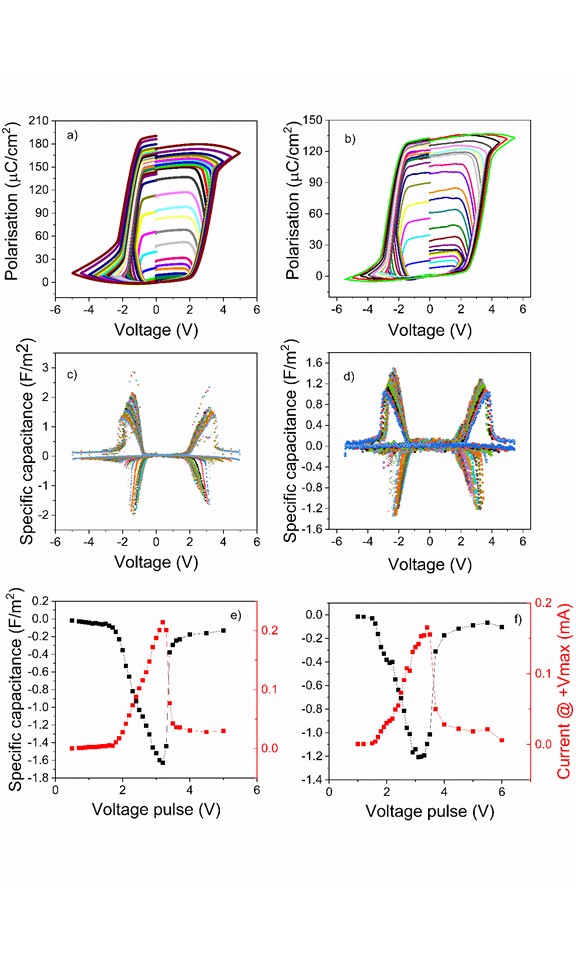
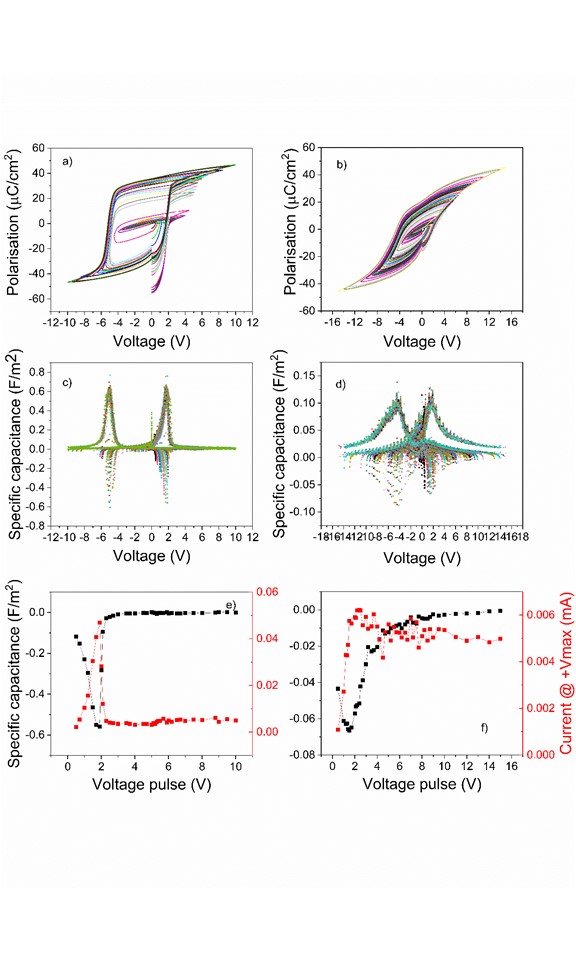
Electric measurements on PZT epitaxial (left) and polycrystalline films (right)
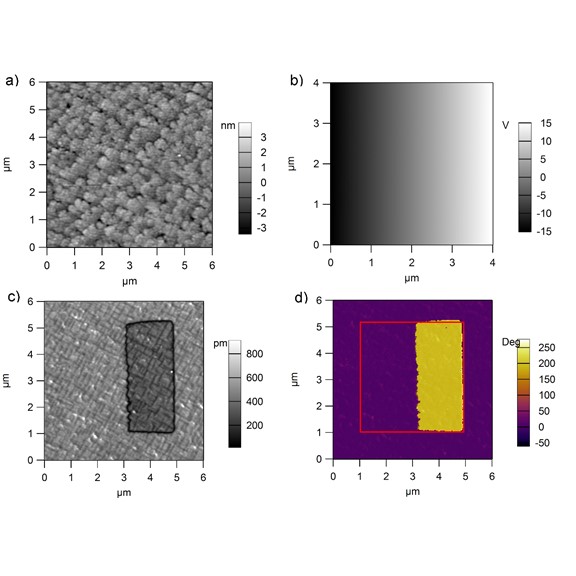
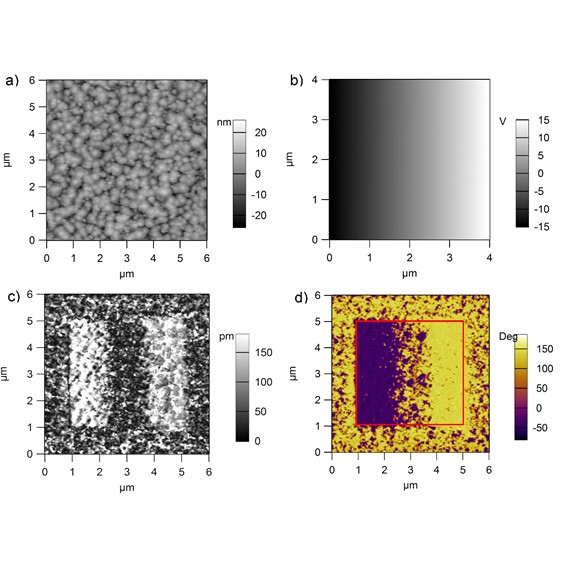
PFM images (topography, amplitude and phase) for epitaxial PZT (left) and polycrystalline (right) films.
A last hour result is the change of polarization orientation by changing the doping of the epitaxial PZT from n-type (Nb doping) with polarization upward to p-type (Fe doping) with polarization downward. The evidence is in the PFM phase images below.
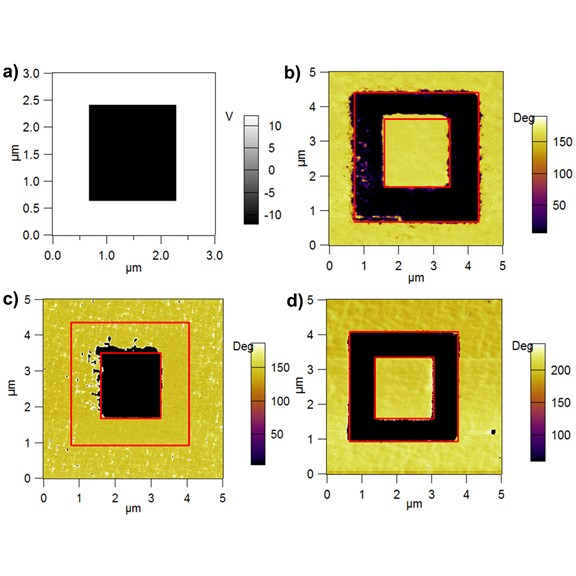
Box-in-box poling map (a) of PZT-Nb (b), PZT-Fe (c) and undoped PZT (d). One can observe that the surface outside the boxes has the same color as the inside box for PZT-Nb and undoped PZT, meaning polarization upward in n-type PZT (undoped PZT is n-type due to oxygen vacancies). For the PZT-Fe the surface outside the boxes has the same color as the outer box, meaning polarization downward in p-type PZT (results published in Scientific Reports 12, 755 (2022)).
The electric and electronic properties of PZT-Nb and PZT-Fe are summarized in the next table.
| Sample | Pr(μC/cm2) | EC(kV/cm) | Eint(kV/cm) | εS | Φ0 (eV) | Neff (1018 cm-3) |
| PZT | 67 | 247 | 11.8 | 175 | 0.15±0.0025 | (5-7) |
| PZT-Fe | 51 | 130 | 23.5 | 225 | 0.11±0.009 | (6-8) |
| PZT-Nb | 76 | 338 | 26.5 | 207 | 0.32±0.02 | (3-5) |
Interesting results were further obtained in 2022, in collaboration with project partners but also in collaboration with external partners.
For example, in collaboration with researchers from Demokritos research center from Greece, we have demonstrated the presence of a metastable ferroelectric phase in very thin HZO layers (results published in COMMUNICATIONS PHYSICS 5, 178 (2022))
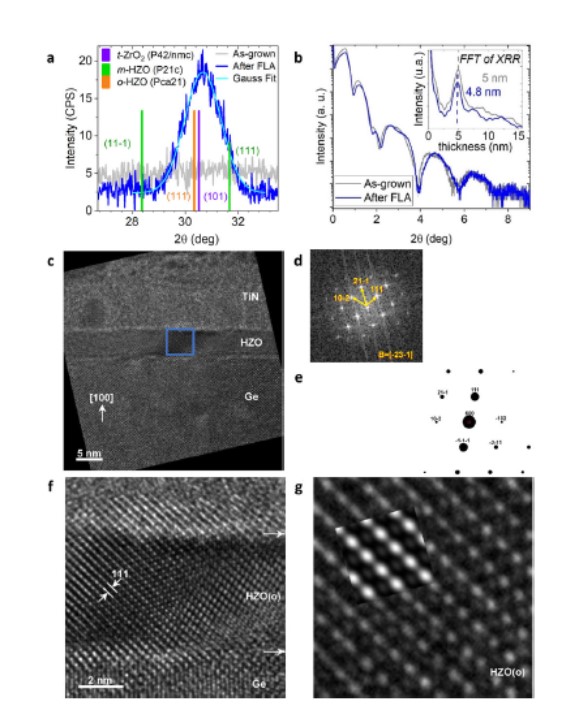
Structural investigation of the very thin HZO layer, demonstrating a good crystallization and the presence of the orthorhombic (O) ferroelectric phase.
Another interesting result is that ferroelectricity modulates the polaronic coupling at multiferroic interfaces. The study was performed on PZT and BTO thin films grown on LSMO substrates, and the results were recently published in COMMUNICATIONS PHYSICS 5, 209 (2022).
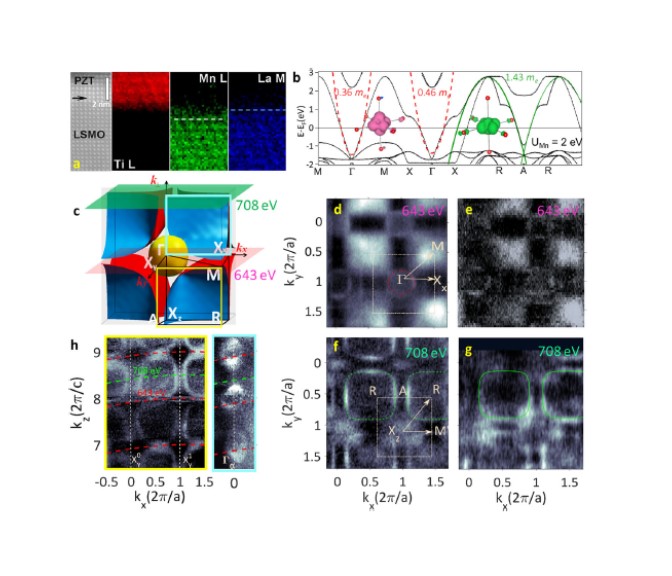
a High resolution high-angle annular dark-field scanning transmission electron microscopy image at the
PbZr0.2Ti0.8O3-La0.7Sr0.3MnO3 (PZT|LSMO) interface, and Ti L, Mn L and La M maps at atomic level. The black arrow indicates the first ferroelectric
unit cell (b) Theoretical Hubbard U - corrected density functional theory band structure for SrTiO3-strained pseudocubic LSMO and (insets) local
density of states integrated ± 0.2 eV around the Г and A bands bottom. (c) Calculated Fermi surface (FS) for strained LSMO. d, e In-plane FS maps for
respectively bare LSMO and BaTiO3 (BTO) interface, LSMO|BTO in the ГMX planes recorded with hv = 643 eV. f, g In-plane FS maps for respectively
bare LSMO and BaTiO3 (BTO) interface, BTO|LSMO in the XZAR.plane recorded with hv = 708 eV. h Experimental out-of-plane FS maps for the BTO|
LSMO heterostructure in the XYMR and ΓXxXz planes. Colored frames enclosing the out-of-plane FSs encode the probed planes with the corresponding
colors from (c).
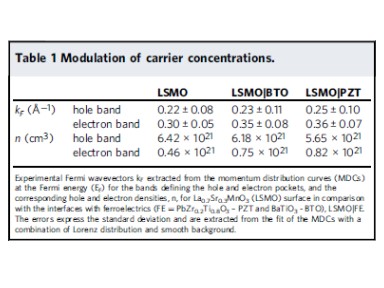
Table showing modulation of carrier concentration due to ferroelectricity.
There are also other interesting results which were not published yet. For example, it was found that the I-V characteristic of a ferroelectric p-n homojunction based on tetragonal PZT is quasi-linear, suggesting a resistive like behavior (see the graph below for a p-n homojunction with equal thicknesses of the component layers, of 100 nm). n-type conduction was obtained by doping with Nb, while p-type conduction was obtained by doping with Fe.
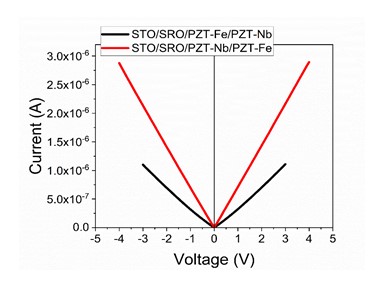
This behavior was explained assuming that the total current flowing through the ferroelectric p-n homojunctions is formed by summing the electron and hole currents injected at the electrode interfaces:
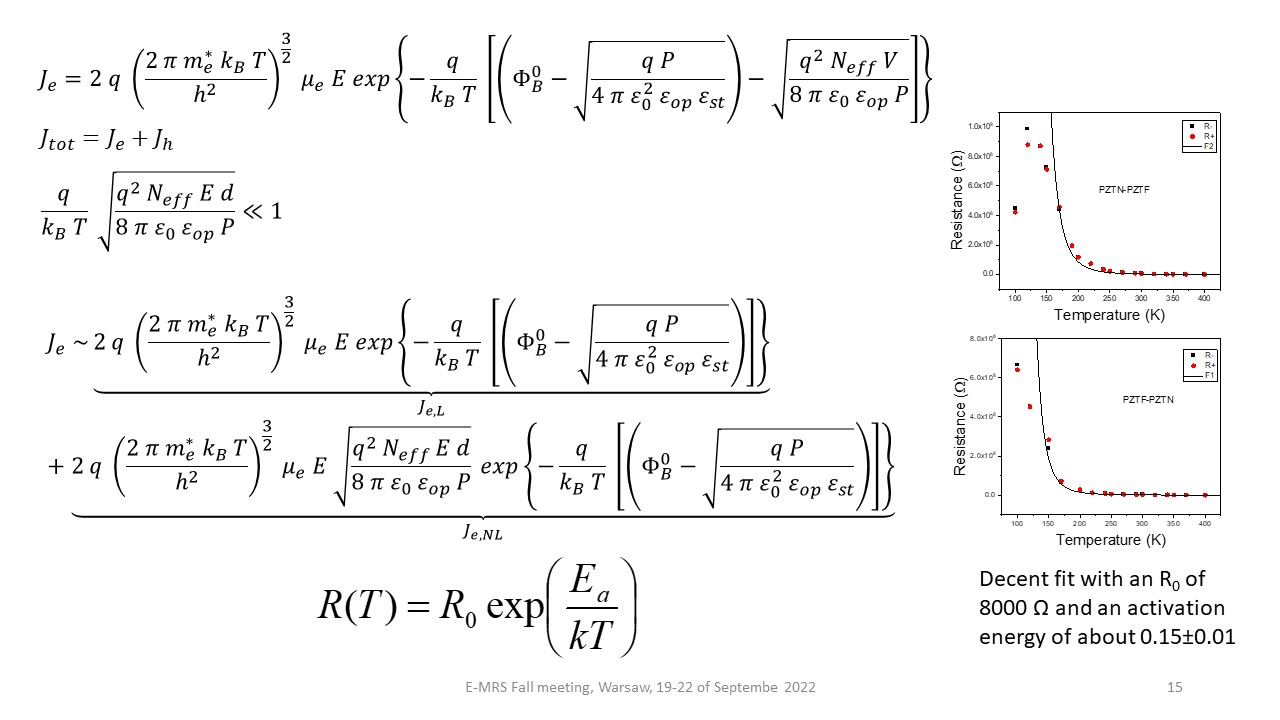
These results were presented for the first time at the international conference E-MRS Fall Meeting, held in Warsaw.
At present the PI is working on a new model for polarization switching in displacive ferroelectrics, based on the hypothesis that the switching is completely homogeneous, flip-flop type, and is triggered by the charge injection at electrode interfaces (invited presentations at E-MRS Spring Meeting and AMSE 2022, both presentations were on-line).
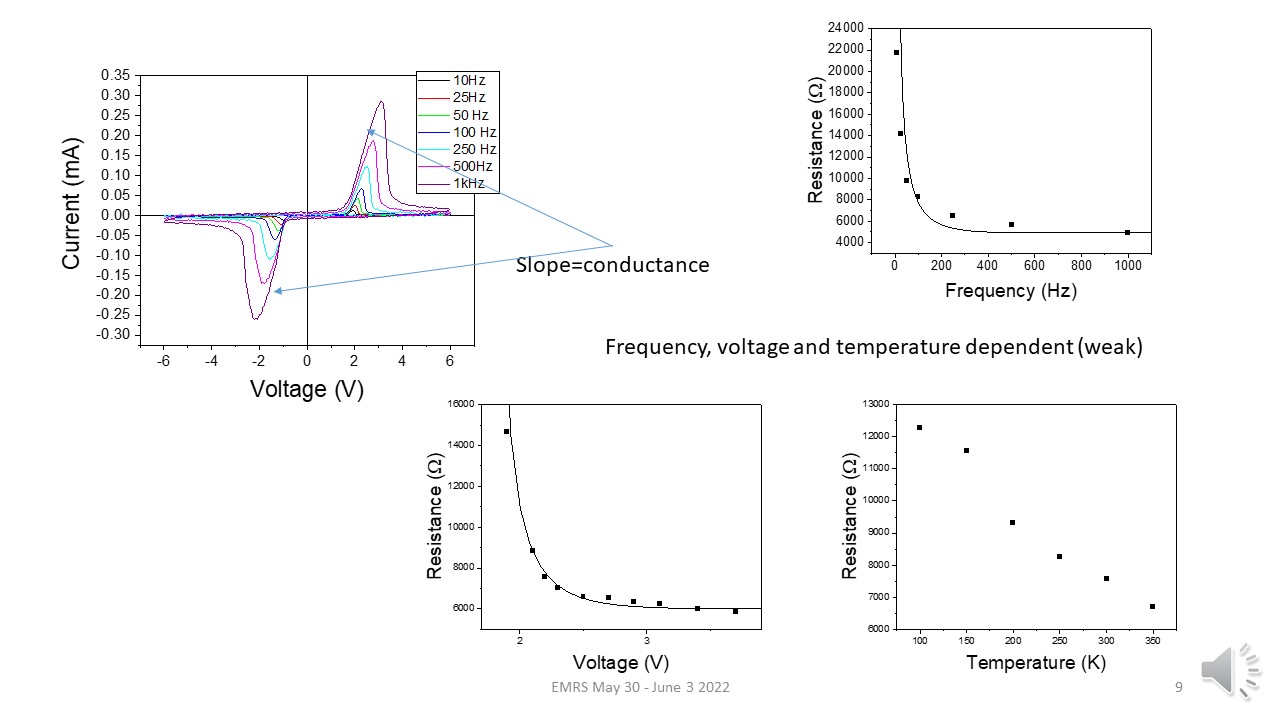
The hypothesis is base on the observation that the increasing part of the current peak recorded during polarization switching has a quasi-linear dependence on the applied voltage, therefore a conductance/resistance can be estimated from the slope of the I-V representation. This has voltage, frequency and temperature dependence, as shown in the above graphs.
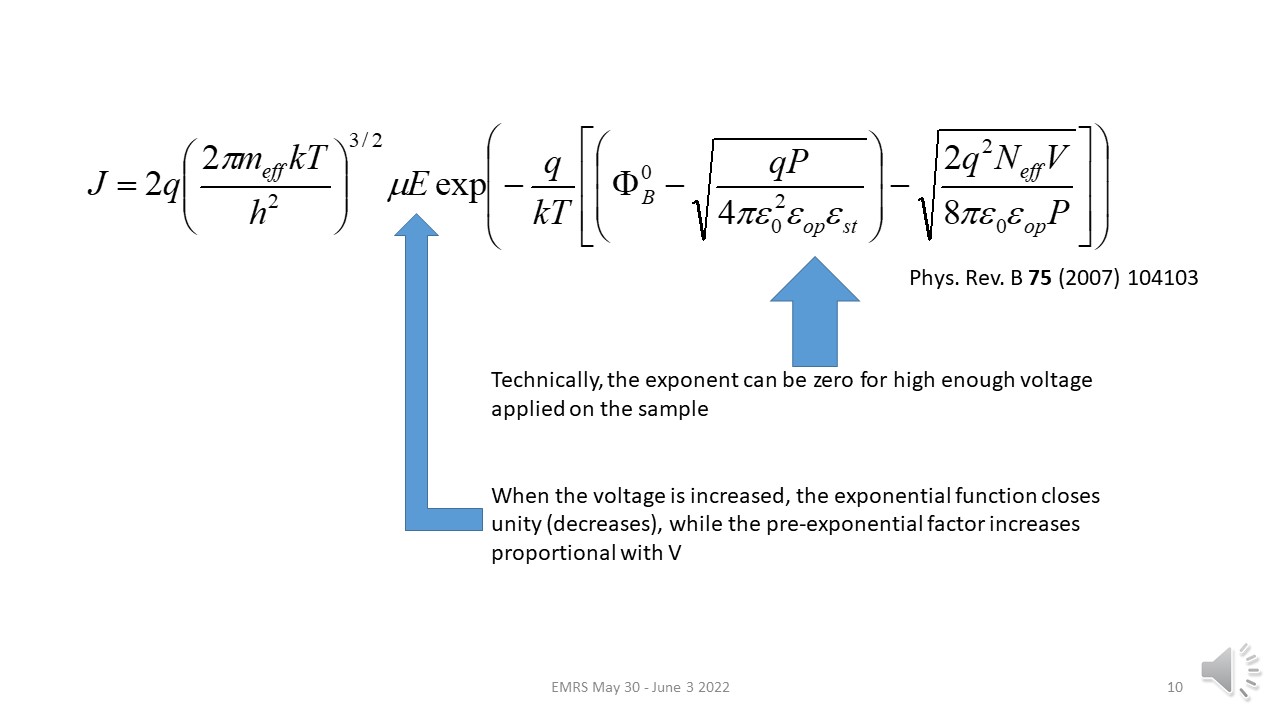
The equation for the current density in the case of a Schottky injection influenced by the bulk mobility of the injected carriers suggests that the exponent can be negligible for high polarization values, low values of the dielectric constant, and large values of the applied voltage. In this case, when the exponential term is negligible (close to unity), the current density has an ohmic like form, as observed experimentally.
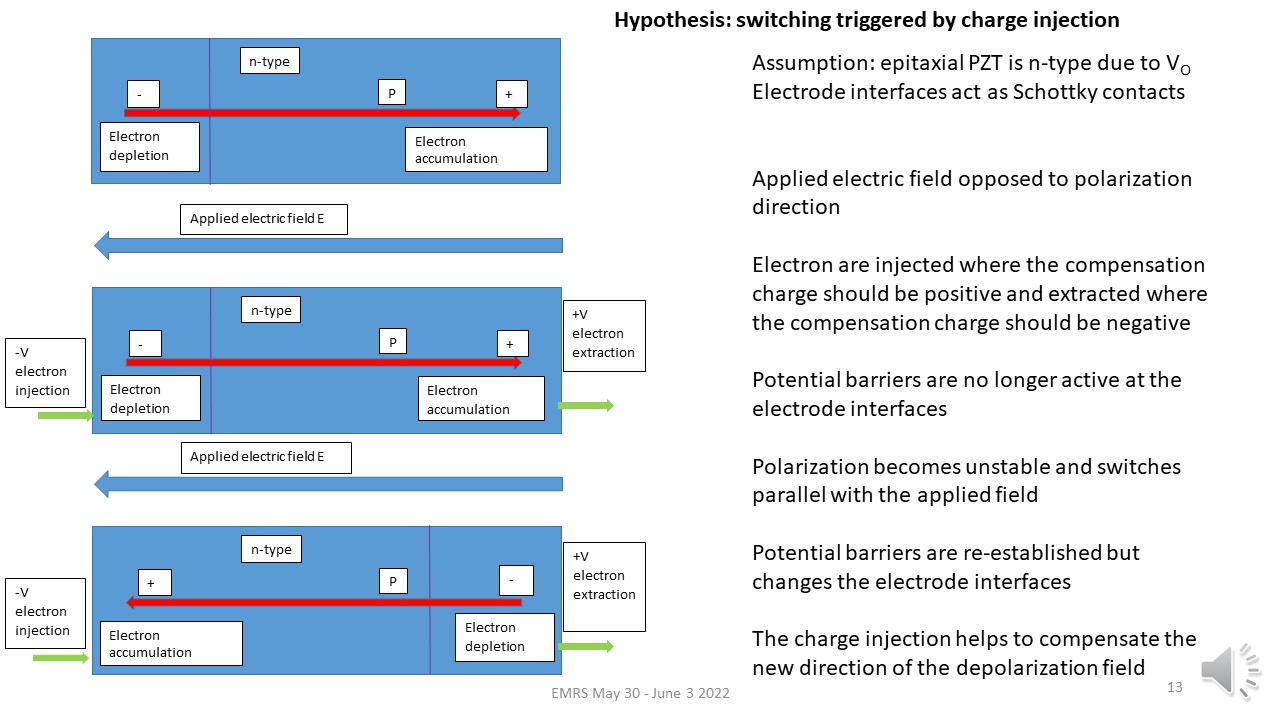
A sketch showing how the injected chares can trigger the polarization switching, just because they destabilize the previous charges involved in the compensation of the depolarization field.
The Project Director is Professor (associated) to the Doctoral School of Physics of the University of Bucharest.
Currently he has 4 PhD students, 2 of them being in the team of the project.
The Responsible of P1 is also Professor (associated) to the Doctoral School of Physics of the University of Bucharest.
He has 2 PhD students in the team.
The Responsible of P3 is Professor at University Politechnica Bucharest and has 2 PhD students in the team.
Updated list of publications
| Nr. | Titlu, jurnal, etc. | Autori | IF | AIS |
| 1 | Memcomputing and Nondestructive Reading in Functional Ferroelectric Heterostructures PHYSICAL REVIEW APPLIED 12, 024053 (2019) DOI 10.1103/PhysRevApplied.12.024053WOS:000482588400002 ISSN 2331-7019 | Georgia A. Boni, Lucian D. Filip ,* Cristina Chirila, Alin Iuga, Iuliana Pasuk, Luminita Hrib, Lucian Trupina, Ioana Pintilie, and Lucian Pintilie | 4.532 | 1.832 |
| 2 | Polarization branches and optimization calculation strategy applied to ABO(3) ferroelectrics MODELLING AND SIMULATION IN MATERIALS SCIENCE AND ENGINEERING 27(4), 045008 (2019) DOI 10.1088/1361-651X/ab146eWOS:000464723100002 ISSN 0965-0393 | Filip, Lucian D.; Plugaru, Neculai; Pintilie, Lucian | 1.826 | 0.672 |
| 3 | Low value for the static background dielectric constant in epitaxial PZT thin films SCIENTIFIC REPORTS 9, 14698 (2019) https://doi.org/10.1038/s41598-019-51312-8 WOS:000489701600034 ISSN 2045-2322 | Georgia Andra Boni, Cristina Florentina Chirila, Luminita Hrib, Raluca Negrea, Lucian Dragos Filip, Ioana Pintilie & Lucian Pintilie | 4.011 | 1.286 |
| 4 | Designing functional ferroelectric interfaces from first-principles: Dipoles and band bending at oxide heterojunctions NEW J. PHYS. 21, 113005 (2019) https://doi.org/10.1088/1367-2630/ab4d8b WOS:000494826200005 ISSN 1367-2630 | Rusu, Dorin; Filip, Lucian; Pintilie, L; Butler, Keith; Plugaru, Neculai | 3.783 | 1.489 |
| 5 | Impact on Ferroelectricity and Band Alignment of Gradually Grown Au on BaTiO3 PHYSICA STATUS SOLIDI-RAPID RESEARCH LETTERS 13(7), 1900077 (2019) DOI 10.1002/pssr.201900077WOS:000477671800008 ISSN 1862-6254 | Popescu, Dana Georgeta; Husanu, Marius Adrian; Chirila, Cristina; Pintilie, Lucian; Teodorescu, Cristian Mihail | 3.729 | 0.790 |
| 6 | The interplay of work function and polarization state at the Schottky barriers height for Cu/BaTiO3 interface APPLIED SURFACE SCIENCE 502, 144101 (2020) DOI 10.1016/j.apsusc.2019.144101WOS:000498639000070 ISSN 0169-4332 | D.G. Popescu1,∗, M.A. Husanu1, C. Chirila1, L. Pintilie1 and C.M. Teodorescu1 | 5.155 | 0.671 |
| 7 | (Ba,Sr)TiO3 solid solutions sintered from sol-gel derived powders: An insight into the composition and temperature dependent dielectric behavior CERAMICS INTERNATIONAL 46(4), pp. 4180-4190 (2020) DOI 10.1016/j.ceramint.2019.10.136WOS:000512219600018 ISSN 0272-8842 | Roxana Elena Patru1, Constantin Paul Ganea1, Catalina-Andreea Stanciu2, Vasile-Adrian Surdu2, Roxana Trusca2, Adelina-Carmen Ianculescu2*, Ioana Pintilie1*, Lucian Pintilie1
| 3.450 | 0.454 |
| 8 | Polarization Switching and Negative Capacitance in Epitaxial PbZr0.2Ti0.8O3 Thin Films PHYSICAL REVIEW APPLIED 14, 014080 (2020) DOI 10.1103/PhysRevApplied.14.014080WOS:000553429500002 ISSN 2331-7019 | Lucian Pintilie, Georgia Andra Boni, Cristina Chirila, Luminita Hrib, Lucian Trupina, Lucian Dragos Filip, and Ioana Pintilie | 4.194 | 1.649 |
| 9 | Resistance hysteresis correlated with synchrotron radiation surface studies in atomic sp2 layers of carbon synthesized on ferroelectric (001) lead zirconate titanate in an ultrahigh vacuum RSC Adv. 10, 1522 (2020) DOI 10.1039/c9ra09131aWOS:000507296300035 eISSN 2046-2069 | Nicoleta Georgiana Apostol, Daniel Lizzit, George Adrian Lungu, Paolo Lacovig, Cristina Florentina Chiril˘a, Lucian Pintilie, Silvano Lizzit and Cristian Mihai Teodorescu | 3.119 | 0.516 |
| 10 | Energy storage performance of ferroelectric ZrO2 film capacitors: effect of HfO2:Al2O3 dielectric insert layer, JOURNAL OF MATERIALS CHEMISTRY A 8, 14171–14177 (2020). DOI: 10.1039/d0ta04984k WOS:000551538000029 ISSN 2050-7488 | J. P. B. Silva*, J. M. B. Silva, K. C. Sekhar*, H. Palneedi*, M. C. Istrate, R. F. Negrea, C. Ghica, A. Chahboun, M. Pereira and M. J. M. Gomes, | 11.301 | 1.999 |
| 11 | Polarization-dependent magnetism of the Ni/BaTiO3 interface, PHYSICAL REVIEW MATERIALS 4, 034402 (11 pp.) (2020). DOI: 10.1103/PhysRevMaterials.4.034402 WOS:000517972500002 ISSN 2475-9953 | A. E. Bocirnea, D. G. Popescu*, C. Chirila, R. M. Costescu, V. Kuncser, V. Stancu, L. Trupina, I. Pasuk, A. M. Vlaicu, M. A. Husanu and C. M. Teodorescu | 3.337 | 1.154 |
| 12 | Effect of strain and stoichiometry on the ferroelectric and pyroelectric properties of the epitaxial Pb(Zr0.2Ti0.8)O3 films deposited on Si wafers MATERIALS SCIENCE AND ENGINEERING B-ADVANCED FUNCTIONAL SOLID-STATE MATERIALS 266, 115042 (2021) https://doi.org/10.1016/j.mseb.2021.115042 WOS:000621174300004 ISSN 0921-5107 | C. Chirila, G. A. Boni, L. D. Filip, M. A. Husanu, S. Neatu, C. Istrate, L. G. Le Rhun, B. Vilquin, L. Trupina, I. Pasuk, M. Botea, I. Pintilie, L. Pintilie | 4.706 | 0.605 |
| 13 | Negative capacitance in epitaxial ferroelectric capacitors evidenced by dynamic dielectric characterization MATERIALS TODAY COMMUNICATIONS 26, 102076 (2021) https://doi.org/10.1016/j.mtcomm.2021.102076 WOS:000635374100004 eISSN 2352-4928 | G. A. Boni, C. F. Chirila, L. D. Filip, I. Pintilie, L. Pintilie | 2.678 | 0 |
| 14 | The role of interface defect states in n and p-type Ge Metal-Ferroelectric-Semiconductor structures with Hf0.5Zr0.5O2 ferroelectric PHYSICA STATUS SOLIDI A: APPLICATIONS AND MATERIALS SCIENCE 218, 2000500 (2021) https://doi.org/10.1002/pssa.202000500 WOS:000605180400001 ISSN 1862-6300 | Georgia A. Boni, Cosmin M. Istrate, Christina Zacharaki, Polychronis Tsipas, Stefanos Chaitoglou, Evangelos K. Evangelou, Athanasios Dimoulas, Ioana Pintilie, Lucian Pintilie | 1.759 | 0.471 |
| 15 | Ferroelectricity in thin films driven by charges accumulated at interfaces PHYSICAL CHEMISTRY CHEMICAL PHYSIC 23, 4085-4093 (2021) https://doi.org/10.1039/D0CP05617K WOS:000621595300004 ISSN 1463-9076 | C. M. Teodorescu | 3.430 | 0.854 |
| 16 | Accidental Impurities in Epitaxial Pb(Zr0.2Ti0.8)O-3 Thin Films Grown by Pulsed Laser Deposition and Their Impact on the Macroscopic Electric Properties NANOMATERIALS 11, 1177 (2021) DOI 10.3390/nano11051177WOS:000657014200001 eISSN 2079-4991 | Georgia Andra Boni, Cristina Florentina Chirila, Viorica Stancu, Luminita Amarande, Iuliana Pasuk, Lucian Trupina, Cosmin Marian Istrate, Cristian Radu, Andrei Tomulescu, Stefan Neatu, Ioana Pintilie, Lucian Pintilie | 4.324 | 0.671 |
| 17 | Electro-active properties of nanostructured films of cytosine and guanine nucleobases NANOTECHNOLOGY 32, 415702 (2021) https://doi.org/10.1088/1361-6528/ac10e4 WOS:000675211200001 ISSN 0957-4484
| Marcela Socol, Lucian Trupina, Aurelian-Catalin Galca, Cristina Chirila, George E. Stan, Aurel-Mihai Vlaicu, Anda Elena Stanciu, Andra Georgia Boni, Mihaela Botea, Anca Stanculescu, Lucian Pintilie, Bogdana Borca | 3.551 | 0.706 |
| 18 | Nd-doped ZnO films grown on c-cut sapphire by pulsed-electron beam deposition under oblique incidence APPLIED SURFACE SCIENCE 563, 150287 (8 pp.) (2021). DOI: 10.1016/j.apsusc.2021.150287 WOS: 000691459900003 ISSN 0169-4332 | M. Nistor, E. Millon, C. Cachoncinlle, C. Ghica, C. Hebert, and J. Perriere | 6.707 | 0.873 |
| 19 | Band-order anomaly at the gamma-Al2O3/SrTiO3 interface drives the electron-mobility boost ACS Nano 15, 4347–4356 (2021). DOI10.1021/acsnano.0c07609 WOS: 000634569100054 ISSN 1936-0851 | A. Chikina, D. V. Christensen, V. Borisov, M. A. Husanu, Y. Z. Chen, X. Q. Wang, T. Schmitt, M. Radovic, N. Nagaosa, A. S. Mishchenko, R. Valenti, N. Pryds, and V. N. Strocov | 15.881 | 3.681 |
| 20 | Homogeneous versus Inhomogeneous Polarization Switching in PZT Thin Films: Impact of the Structural Quality and Correlation to the Negative Capacitance Effect NANOMATERIALS 11, 2124 (2021). https://doi.org/10.3390/nano11082124 WOS:000690109600001 eISSN 2079-4991 | Lucian Pintilie, Georgia Andra Boni, Cristina Florentina Chirila, Viorica Stancu, Lucian Trupina, Cosmin Marian Istrate, Cristian Radu and Ioana Pintilie | 5.076 | 0.756 |
| 21 | New solid forms of the diuretic compound 4-Chloro Salicylic Acid-5-Sulfonamide JOURNAL OF MOLECULAR STRUCTURE 1241, 130682 (2021). https://doi.org/10.1016/j.molstruc.2021.130682 WOS:000670212600013 ISSN 0022-2860 | Turza A., Miclaus O. M, Zarbo L., David M., Kacso I., Borodi G. | 3.196 | 0.293 |
| 22 | Controlling polarization direction in epitaxial Pb(Zr0.2Ti0.8)O3 films through Nb (n-type) and Fe (p-type) doping SCIENTIFIC REPORTS 12, 755 (2022) https://doi.org/10.1038/s41598-022-04802-1 WOS:000804787700053 ISSN 2045-2322
| Cristina Florentina Chirila, Viorica Stancu, Georgia Andra Boni, Iuliana Pasuk, Lucian Trupina, Lucian Dragos Filip, Cristian Radu, Ioana Pintilie, and Lucian Pintilie | 4.380 | 1.285 |
| 23 | Progress and perspective on different strategies to achieve wake-up-free ferroelectric hafnia and zirconia-based thin films APPLIED MATERIALS TODAY 26, 101394 (2022) https://doi.org/10.1016/j.apmt.2022.101394 WOS:000820423500003 ISSN 2352-9407 | J.P.B. Silva, K.C. Sekhar, R.F. Negrea , J.L. MacManus-Driscoll, L. Pintilie
| 10.41 | 1.775 |
| 24 | Electrode dependence of polydomain stability in ferroelectric thin films SCRIPTA MATERIALIA 213, 114589 (2022) DOI 10.1016/j.scriptamat.2022.114589WOS:000791227200005 ISSN 1359-6462 | I. B. Misirlioglu and L. Pintilie | 5.611 | 1.409 |
| 25 | Metastable ferroelectricity driven by depolarization fields in ultrathin Hf0.5Zr0.5O2 COMMUNICATIONS PHYSICS 5, 178 (2022) https://doi.org/10.1038/s42005-022-00951-x WOS:000821604300002 ISSN 2399-3650 | N. Siannas, P. Tsipas, C. Zacharaki, S. Chaitoglou, L. Bégon-Lours, C. Istrate, L. Pintilie, A. Dimoulas | 6.368 | 2.365 |
| 26 | Nanoscopic correlations from curve fitting of photoelectron spectromicroscopy data cubes of lead zirconate titanate films Ultramicroscopy, submitted (2021). | L. E. Abramiuc, L. C. Tănase, A. Barinov, C. F. Chirilă, C. M. Teodorescu | 2.689 | 0.923 |
| 27 | Self-consistently derived sample permittivity in stabilization of ferroelectricity due to charge accumulated at interfaces PHYS. CHEM. CHEM. PHYS.24, 5419 (2022) DOI: 10.1039/d1cp05222e WOS:000755898700001 ISSN 1463-9076 | C. M. Teodorescu | 3.676 | 0.823 |
| 28 | Ferroelectricity modulates polaronic coupling at multiferroic interfaces COMMUNICATIONS PHYSICS 5, 209 (2022) https://doi.org/10.1038/s42005-022-00983-3 WOS:000840841900001 ISSN 2399-3650 | Marius Adrian Husanu, Dana Georgeta Popescu, Federico Bisti, Luminita Mirela Hrib, Lucian Dragos Filip, Iuliana Pasuk, Raluca Negrea, Cosmin Istrate, Leonid Lev, Thorsten Schmitt, Lucian Pintilie, Andrey Mishchenko, Cristian Mihail Teodorescu and Vladimir N. Strocov | 6.368 | 2.365 |
| 29 | Memory Window Enhancement in Antiferroelectric RAM by Hf Doping in ZrO2 IEEE ELECTRON DEVICE LETTERS 43 (9), pp.1447-1450 (2022) DOI 10.1109/LED.2022.3189159WOS:000845067200018 ISSN 0741-3106 | Lomenzo, Patrick D.; Li, Songrui; Pintilie, Lucian; Istrate, Cosmin M.; Mikolajick, Thomas; Schroeder, Uwe | 4.816 | 0.931 |
| 144.063 | 33.298 |
Deposition of epitaxial ferroelectric films by PLD.
Complex electrical, photovoltaic and pyroelectric characterization of ferroelectric based structures.
Development of applications, such as memory devices, field effect transistors or pyroelectric detectors.
PROJECTS/ NATIONAL PROJECTS
Copyright © 2025 National Institute of Materials Physics. All Rights Reserved
